Myth Maker. Film Noir Pioneer. Expressionist Prophet?
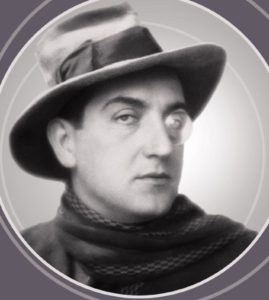 Fritz Lang. The monocoled genius of the screen.
Fritz Lang. The monocoled genius of the screen.
I first encountered Lang in a beat-up copy of Metropolis – a copy I wouldn’t even finish. The images, though from a well-worn, many-times-duped copy, were stunning.
And I couldn’t follow anything. One could hardly blame me; this was a version which didn’t follow the original plot and subplots…and too much of the detail was washed out to fully appreciate what was happening.
In 2011, I was at my parents’ house for my dad’s birthday. He’d started a streaming Netflix account and I wasn’t feeling super well that day, so I was in the TV room and hunted around for things to watch. And there it was… the full-length, restored version of Metropolis. I knew just enough to know that I should check this film out. So, while relatives swirled around me, I drank in the plot & subplots which were all seasoned by – nay, drenched in – Gottfried Huppertz’s fantastic score which had been newly recorded for this Kino Video release.
What is it about Lang’s storytelling that makes him stand out?
Silent film is a medium unto itself. Reared in this tradition, Lang made a successful transition to talkies. But so what? So did a number of other talented professionals. DeMille made movies almost until the 1960s, many of them with dialogue. Henry King, known for films like Tol’able David continued making films even into the 1950s, such as David and Bathsheba. And yet, neither King nor DeMille had quite the same touch for storytelling that Lang had.
Lang’s secret is himself. He sees and wants his audiences to see his characters’ eyes, their inner life.
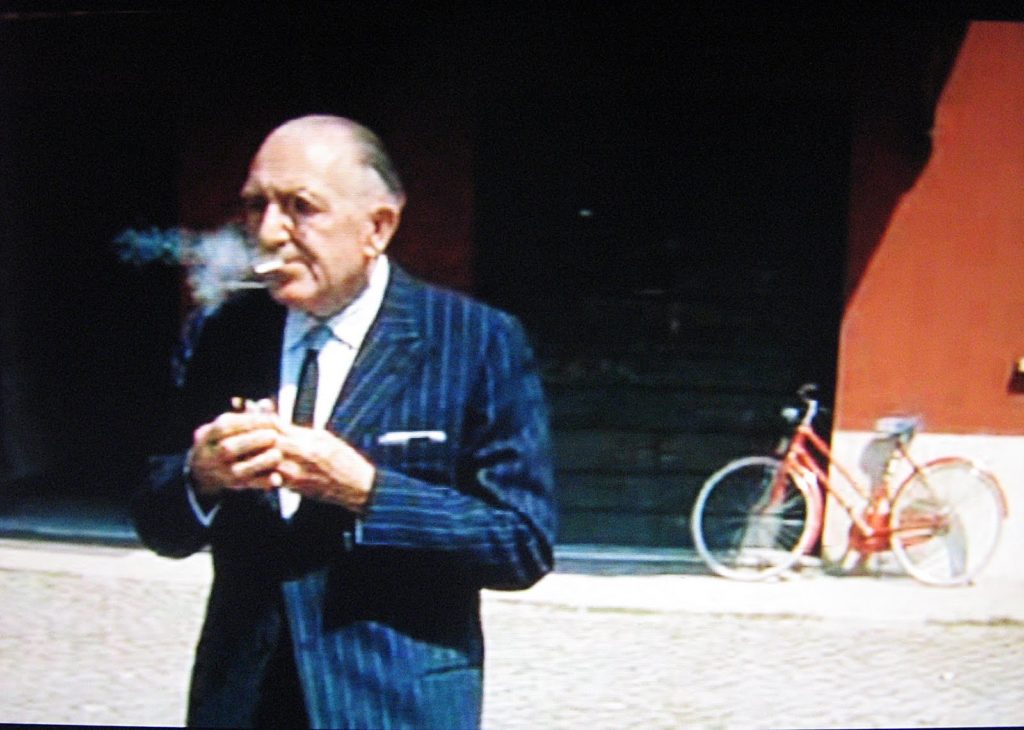
Fritz Lang playing himself in Jean-Luc Godard’s CONTEMPT (1963).
One of the reasons Lang is compelling is that much of his material in the silent era was written by his then-wife, Thea von Harbou. From their collaborative efforts flowed classics like Destiny, Dr. Mabuse, Metropolis, Woman in the Moon, and even M. But a great script can make for a terrible movie (Quantum of Solace, anyone?), so Harbou’s influence can’t be the magic bullet.
No, I think that Lang’s secret is himself. He sees and wants his audiences to see his characters’ eyes, their inner life. This is seen in Kay Hoog’s character in Spiders, Haghi in Spies, Dr. Mabuse (in the movies which bear his name), No. 326 (also in Spies), …really, the list could go on and on. Even when the character is physically improbable, such as Death or the specter of Dr. Mabuse in The Testament of Dr. Mabuse, one is drawn to their actions, their world.
Lang’s secret is himself.
I’m happy to have contributed to this month’s Film Admission on Fritz Lang. I hope you will find time to enjoy him as many of us here at ZekeFilm have.
– David L. Gill
Clash by Night
1952, RKO Radio Pictures, dir. Fritz Lang
by Jeffrey Knight
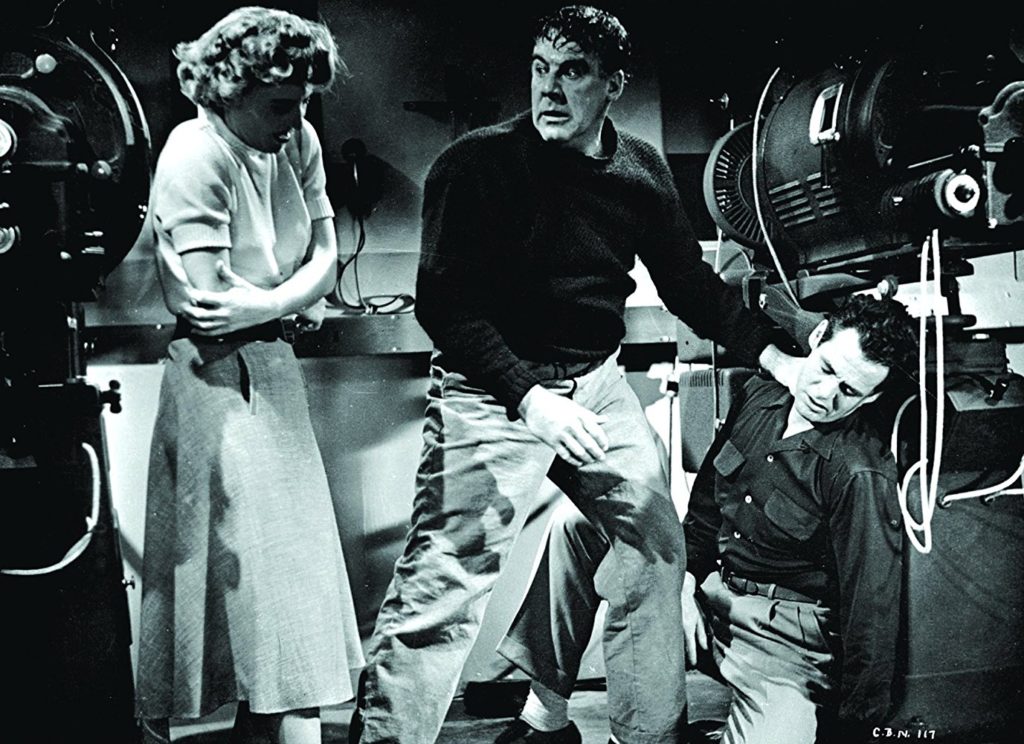
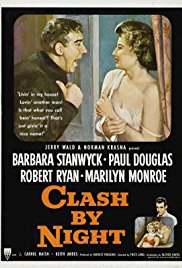 Naturally I’ve heard of Fritz Lang. Who has an interest in film art and film history who hasn’t? I’d seen Metropolis dozens of times- in versions ranging from the Giorgio Moroder rock-opera scored version from the 1980s to versions on the big screen accompanied by live musicians. I’d seen M, and wrote papers in school analyzing its portrayals of state authority in a Germany increasingly coming under Nazi control, and papers on its symbolic use of reflections . I knew Fritz Lang.
Naturally I’ve heard of Fritz Lang. Who has an interest in film art and film history who hasn’t? I’d seen Metropolis dozens of times- in versions ranging from the Giorgio Moroder rock-opera scored version from the 1980s to versions on the big screen accompanied by live musicians. I’d seen M, and wrote papers in school analyzing its portrayals of state authority in a Germany increasingly coming under Nazi control, and papers on its symbolic use of reflections . I knew Fritz Lang.
Except, of course, that I didn’t.
Not really, anyway. When this month’s Film Admission’s topic was announced, I found I had to do my research to find a Fritz Lang movie to watch. This was not because I had seen so many of them. Rather, it was because that, except for Metropolis and M (and Dr. Mabuse the Gambler), I hadn’t seen any of them, and I had no idea what else he had done once Lang left Germany. So there’s a real Film Admission for you.
Clash by Night is a noir-ish melodrama from 1952 starring Barbara Stanwyck, Paul Douglas, Robert Ryan and Marilyn Monroe. Based on a play by Clifford Odets, the movie tells the story of Mae Doyle (Stanwyck), a young woman who returns to the small California fishing village where she grew up. Mae left town years ago to find fame and fortune, but comes home with only bitter memories of a failed affair. She tries to start her life over, finding stability in a relationship with a Jerry D’Amato (Douglas). He’s a solid, kind-hearted man who makes a good living captaining a fishing boat and could provide a nice life for anybody. Mae grows dissatisfied with ‘nice’ over time, however. She soon starts becoming attracted to Earl Pfeiffer (Ryan), a loud-mouthed misogynistic jerk who has his own marital problems.
Lang learned his craft directing silent films, and the skills he developed then still work in 1952, more than 20 years past the silent film era. Clash by Night opens with an extended sequence, over 6 minutes long in a film that just runs 105, that wordlessly depicts the daily life in the small town (or nearly wordlessly- there’s a brief line of dialogue, but it’s not vital). It shows us everything we need to see to get a sense of this time and place: the fishing boats heading out to sea, the gulls and sea lions, workers waking up and heading to the cannery, the catch being dumped into the assembly line, and so on. No narration required, or desired.
There’s another sequence, later on in the movie, where we watch Jerry’s growing suspicions about his wife. Again, the whole thing plays out visually. Closeups of clocks show that the time is growing late. Jerry picks up the clock and cradles it- he’s obviously worried. Suspicions placed in his mind by his uncle earlier that day are taking hold. Jerry goes into his bedroom- the bed is pristine- like it has never been used. He now knows he’s right to be concerned.
Both Metropolis and M demonstrate that Lang’s not afraid to use the overt visual metaphor. That was probably the best arrow in a silent film director’s quiver, and few directors knew when or how to use it better than Lang. Even at the tail end of his Hollywood career (and indeed, his career directing films at all – his last film was released in 1960), Lang’s sense of the visual metaphor is as strong (and unsubtle) as ever. When Mae returns home, she literally has to cross to the other side of the tracks to get there. Earl sits outside of a cafe, a mural of an octopus and its eight grasping tentacles looms behind him. Mae realizes she’s deeply unhappy with her life with Jerry, cut to a series of shots depicting waves crashing against the rocks. Earl emerges from a spare bedroom after passing out drunk at Jerry and Mae’s house, the door he comes through is small so he looms large in it while Mae’s thoughts are consumed by him.
When surveying Lang’s best work, even leaving out M and Metropolis, Clash by Night doesn’t quite rank in the top tier. But as it’s my first exposure to Lang’s Hollywood work, I have to give it full props. Clash by Night has reminded me that Lang is a master director, both of sound films and silent, both in Germany and California. His ability to tell a story visually was born of necessity during the silent era, but his consummate artistry serves him well even when the pictures talk. I’ll be catching up on all of the Lang films I’ve missed, and I look forward to each and every one.
M
1931, Nero-Film AG, dir. Fritz Lang
by Lydia Hardy
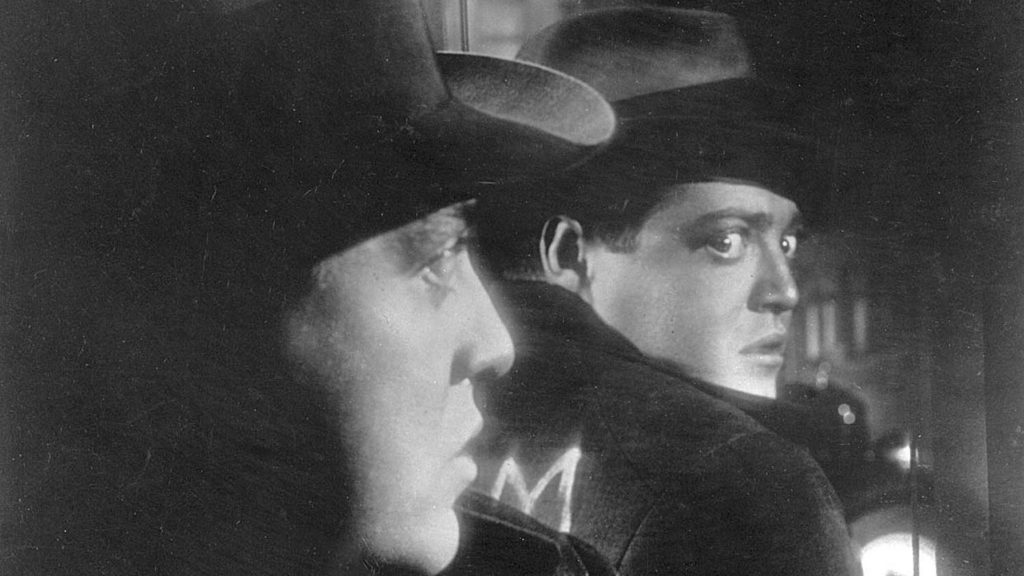
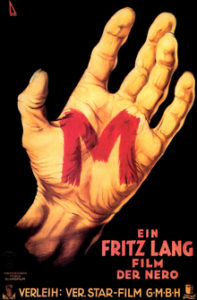 Fritz Lang’s iconic film M was released in Germany in 1931 less than two years before Adolph Hitler was appointed Chancellor. The movie tells the story of a city plagued by a killer of children, a sick man who contacts the police and later the press throwing the population into hysteria. The police encounter great difficulty in apprehending the killer, but luckily this town has a well-organized crime syndicate that is both appalled by the crimes and annoyed by the constant vigilance of the police.
Fritz Lang’s iconic film M was released in Germany in 1931 less than two years before Adolph Hitler was appointed Chancellor. The movie tells the story of a city plagued by a killer of children, a sick man who contacts the police and later the press throwing the population into hysteria. The police encounter great difficulty in apprehending the killer, but luckily this town has a well-organized crime syndicate that is both appalled by the crimes and annoyed by the constant vigilance of the police.
The criminals in the city take it upon themselves to capture the madman whom they believe to be very different from themselves. This aspect of the film invites commentary and I’m certain it always has. While the film raises many a politically-charged question it doesn’t really attempt to answer them.
The majority of the film is a lesson in the art of restraint and suspense. The dark shadow that lures the child away, the growing hostility of the city-dwellers toward the police and each other, the separate but equally organized meetings of the police and the criminals, all woven together with claustrophobic tight angles, provide a mid-section of film that makes the viewers head spin and stomach tighten.
The ending of the film, however, is more chilling and less satisfying than one might expect from a movie so full of suspense. The “trial” of the child killer at the hands of the city’s criminals has an eerie, uneasy quality that is brought sharply into focus when the crowd becomes enraged and demands his murder while his “lawyer” attempts to adhere to the laws of the land.
Peter Lorre’s performance during this scene is a powerhouse. He is a desperate and sick man and he is afraid, not only of his fate but of himself and his own mind.
The people’s fear, that a criminally insane man found guilty of so many murders would be cured and released, is indicative of a society whose faith in their systems of justice is unquestionably shattered. And the realization of this is almost creepier than Peter Lorre’s hair-curling monologue.
The questioning of both the justice system and the justice of the people is the enduring theme of M. It’s also the reason that its place in history and geography begs to be considered and the reason for its eerie relevance in today’s America.
There’s also an underlying message about social responsibility to be absorbed from the film. The last words of the grieving mothers demand we keep closer watch over our children. The message that it’s easy to blame the outsider, the “psycho killer”, but the burden of prevention lies upon society and the individuals who populate it.
In short, M is not the kind of movie that elicits gasps and jumps from its audience, but rather, the kind that crawls inside their heads and drives them slowly mad with its implications. It’s arguably the first psychological thriller and it’s a masterpiece.
Metropolis
1927, UFA, dir. Fritz Lang
by Erik Yates
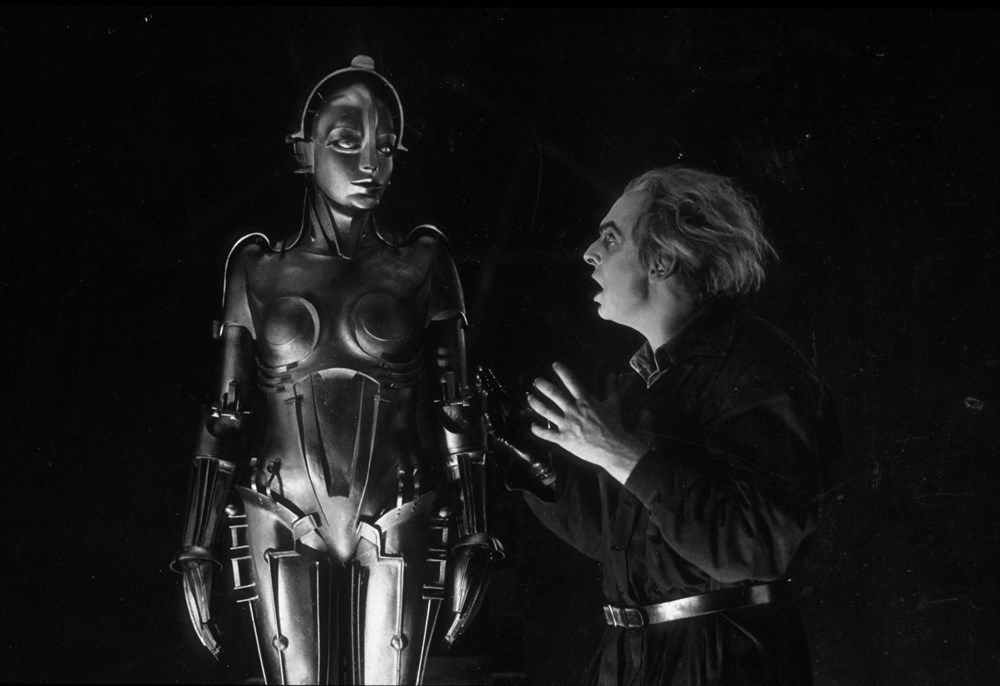
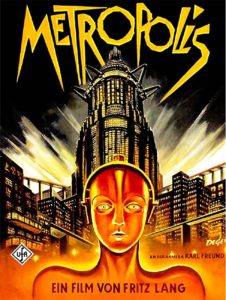 The futuristic Metropolis is obviously a huge admission and a glaring hole in my viewing filmography, but thankfully, due to this month’s “Film Admissions” featured director, Fritz Lang, I’ve successfully filled that hole and can feel confident that there is one less “must-see” film that I haven’t yet viewed. And make no mistake, this is a “must-see” film.
The futuristic Metropolis is obviously a huge admission and a glaring hole in my viewing filmography, but thankfully, due to this month’s “Film Admissions” featured director, Fritz Lang, I’ve successfully filled that hole and can feel confident that there is one less “must-see” film that I haven’t yet viewed. And make no mistake, this is a “must-see” film.
Lang, in a silent film like Metropolis, captures the creativity, beauty, and imagination of George Melies, while laying the foundation for science fiction design aesthetics and tropes that continue to this day. Metropolis still feels contemporary in many ways, as it deals with the socio-economic gap felt between the working class and the city planners. At a time when communism had swept the nation of Russia just ten years earlier, the idea of the working class rising up against the city planners to share equally in the profit of their labor was very radical to a staunchly capitalistic nation like the United States.
The father of communism, Karl Marx was German, and Lang, as an Austrian, spoke the same language and was certainly around the culture of the times. Interestingly, he was offered a job by Joseph Goebbels to be a part of the Nazi’s German Cinema Institute. He turned it down, and fled to Paris and eventually the United States.
The political overtones in his 1927 masterpiece Metropolis, might have given Goebbels the impression that Lang was politically sympathetic to what the Nazi’s were trying to achieve, but I think Goebbels missed the point. In Metropolis, the political overtones aren’t communistic in so much as a worker revolt brings down the capitalist business owners and replaces them with an “everybody contributes and shares equally in a new utopian society” structure any more than it was reflecting the Nazis desire to seize power over anyone it deemed as inferior. Rather, Metropolis reaches across both movements and subverts them, claiming that there is a need to join the workers with those in power, which he deems the “hands” and the “heart”. This isn’t about overturning one group and replacing it with another as much as it is about refining what is, with even greater possibilities, without sacrificing either group.
Of course there is pushback, as anyone fears the unknown. Undergirding it all is the love between the city planner’s son, Freder (Gustav Fröhlich) and Maria (Brigitte Helm), a woman who is leading the uprising of the workers to ask for their fair share. Amid this is the evil Rotwang (Rudolf Klein-Rogge), an inventor who has designed a robot that can take on the look and personality of Maria. Rotwang secretly swaps out the true Maria for his controlled doppelgänger, thus contorting the uprising towards anarchy and chaos. Lang, and his personal/professional partner, Thea von Harbou brilliantly themes of love, power, sex, and disparity, then couple them with built-in commentary on the socio-economic conditions. The filmmakers balanced observations on these conditions, which existed in reality under a largely manufacturing economy, with their futuristic look at technology’s place in the emerging modern world, all as possible tools that could be wielded by the powerful. Though Metropolis it is ninety-one years old, this is a must see-film, absolutely; and I’m thankful to have finally experienced it for myself.
Woman in the Moon (Frau im Mond)
1929, UFA, dir. Fritz Lang
by Jim Tudor
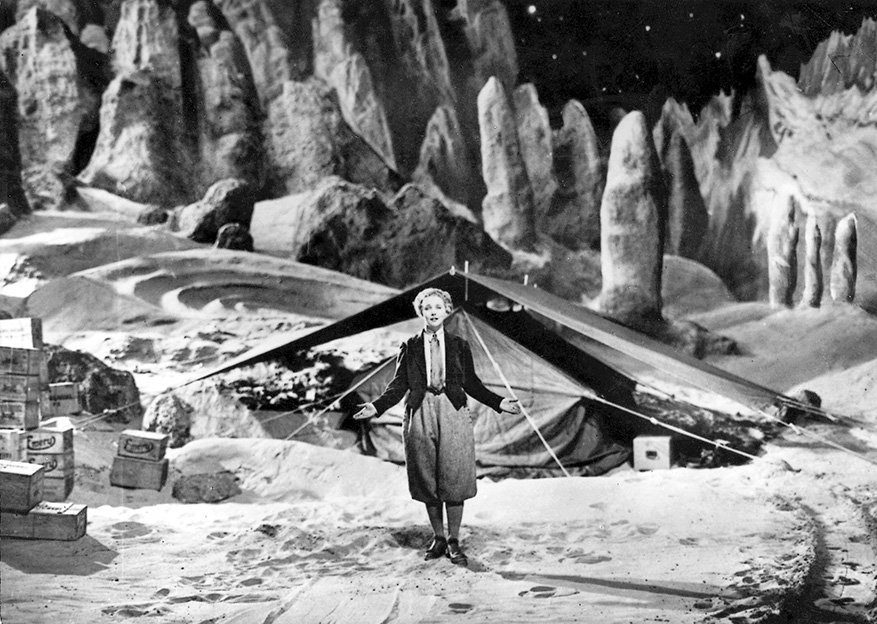
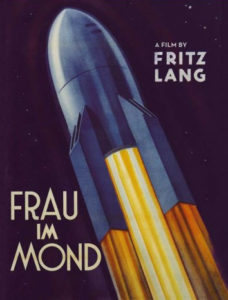 Fritz Lang, as brilliant of a visual stylist as he was, was perhaps first and foremost a myth maker. On screen, he dealt with ancient legends (Die Nibelungen, Liliom), moral futurism (Metropolis), magical lands (Destiny), far away adventures (The Spiders), the Old West (Western Union, Rancho Notorious), and haunting horror (The Testament of Dr. Mabuse). In real life, he’d persist at spinning his own personal myth, about how, as Germany’s biggest filmmaker (though he was Austrian), he was being courted by Goebbels to create Nazi propaganda. Subsequently, the well-worn story goes, he caught the last train to Paris that night, leaving behind his Nazi sympathizer wife and creative partner, Thea von Harbou. Never mind that the timetable is likely very exaggerated; when Lang as an older man would tell the tale, it was as though he’d convinced himself of his own oft-repeated details. In any case, he of course made a valiant, difficult choice by leaving.
Fritz Lang, as brilliant of a visual stylist as he was, was perhaps first and foremost a myth maker. On screen, he dealt with ancient legends (Die Nibelungen, Liliom), moral futurism (Metropolis), magical lands (Destiny), far away adventures (The Spiders), the Old West (Western Union, Rancho Notorious), and haunting horror (The Testament of Dr. Mabuse). In real life, he’d persist at spinning his own personal myth, about how, as Germany’s biggest filmmaker (though he was Austrian), he was being courted by Goebbels to create Nazi propaganda. Subsequently, the well-worn story goes, he caught the last train to Paris that night, leaving behind his Nazi sympathizer wife and creative partner, Thea von Harbou. Never mind that the timetable is likely very exaggerated; when Lang as an older man would tell the tale, it was as though he’d convinced himself of his own oft-repeated details. In any case, he of course made a valiant, difficult choice by leaving.
His 1929 epic silent film Woman in the Moon, made for UFA before all of that, ends (spoiler ahead) with the film’s protagonist making the valiant, difficult choice to stay on the moon. He is then rewarded with the discovery that the woman he’s loved unrequitedly has opted to remain there with him as opposed to heading home with her flop-sweating crazed beau who’s lost his mind and is a coward. This ending, one of many collaborations between Lang and von Harbou, would prove nearly 180 degrees opposite of how their own story would go. Von Harbou would divorce Lang a year following his departure.
It should be mentioned that although Woman in the Moon has been hailed as the first “science based” science fiction film, no space suits or breathing apparatuses of any kind are necessary on Lang’s compellingly rendered lunar surface. One odd bit of trivia: Lang claims to have originated the concept of the ignition countdown, purely as a dramatic device for his film. An actual rocket scientist was actively consulting on the film, resulting in some of the earliest movie renderings of zero gravity and two-stage boosters.
For all that, though, Woman in the Moon proved a disappointment. In a movie that spans nearly three hours, and boasts to rival Lang’s previous sci-fi marvel, Metropolis, in terms of scope, it is fairly flabbergasting that the first half is almost entirely people talking in rooms. The crazed professor talks to our strapping protagonist, Wolf Helius (Willy Fritsch); Helius meets with Friede, his one true love (Gerda Maurus), but is forced to witness her kissing the aforementioned crazed cowardly coward; some badguys tiptoe around stealing important equipment; on and on and on it drags. Speaking as an editor, there’s little here that isn’t completely superfluous, or could’ve been worked out as effectively in a ten minute opening bit.
When the rocket itself is finally taxi-ing to its platform (involving water submersion, oddly enough), Woman in the Moon begins to earn its existence. Being a high-end Fritz Lang silent film, there’s no shortage of arch facial reactions, cool minimalist design, and mythical humanist reach. It’s even progressive enough that it dresses Friede in trousers and a tie for her space travel, a good decade before Katherine Hepburn would wear the pants in Hollywood. But all in all, this is the rare Fritz Lang spectacle that never quite takes off.
The Woman in the Window
1944, Christie Company, dir. Fritz Lang
by Max Foizey
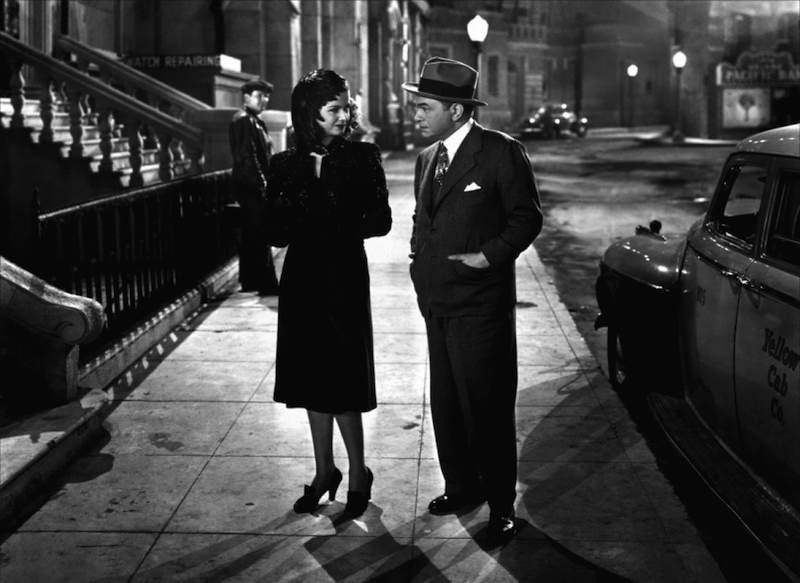
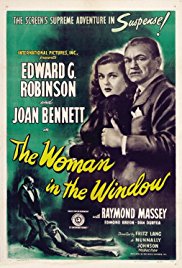 We meet psychology professor Richard Wanley (Edward G. Robinson) as he is giving his class a lecture on the differences between the degrees of murder in the eyes of the law. Once this is established, an abrupt fade to and from black takes us to a train station, with Professor Wanley saying goodbye to his wife and young children, encouraging them to have a good vacation and apologizing that he can’t join them.
We meet psychology professor Richard Wanley (Edward G. Robinson) as he is giving his class a lecture on the differences between the degrees of murder in the eyes of the law. Once this is established, an abrupt fade to and from black takes us to a train station, with Professor Wanley saying goodbye to his wife and young children, encouraging them to have a good vacation and apologizing that he can’t join them.
As he is on his way to join his pals at a club, Wanley notices a portrait of a striking woman in a shop window. Over cigars and drinks at the club, Wanley’s friends inquire as to what shenanigans he plans on taking part in now that he finds himself sans wife and children for a spell. Wanley maintains that he’s far too old for anything exciting. He feels he is at the end of the “brightness of life,” the end of spirit and adventure. In his words, “Life ends at forty.” Wanley stays at the club after his friends leave, treating himself to another drink (his fourth) and reading a bit of The Song of Songs Which Is Solomon’s, before dozing off.
Shortly after 10:30pm that night, the still-sleepy Professor exits the club and walks past the portrait of the woman in the window once more, this time stopping to take in its beauty. Suddenly there are two faces staring at him in the window reflection, as he meets Alice Reed (Joan Bennett), who reveals that it is in fact a painting of her, and she sometimes comes to this street corner to watch people’s reactions to her image. Alice asks Wanley to join her for a drink, assuring him that she isn’t looking for anything romantic. Just one drink.
Next thing you know they are laughing over cocktails at a nearby bar when she mentions she has sketches at her apartment that her portrait painter gave her, if he would like to see them. Wanley demures, looking at his watch and saying it’s late, to which Alice replies “Is that late, 11?”
It’s obvious Wanley has no desire to cheat on his wife, this rabbit hole he finds himself traveling down is strictly an antidote to his feeling of stodginess, his proper resistance of the siren’s call of adventure. Next thing you know he is in her apartment, admiring those sketches, when the apartment door opens and an angry man rushes in, striking Alice across the face. Wanley ends up in a life-or-death struggle with the man. The result is life for Wanley and death for the man. Things only get worse for Wanley from there. He got himself into this mess, but you feel for him as he goes to great lengths to get himself out of it.
Iconic for portraying gangsters and criminals, it’s wonderful watching Edward G. Robinson play an upstanding family man, an “Edward G. Everyman” if you will. Joan Bennett is appropriately evasive as Alice, creating a character whose motivations you never fully trust. In addition to the opening lecture-to-train-station transition, director Fritz Lang creates many memorable scenes and pulls great performances from his cast, in a film that is immensely enjoyable from start to finish. The dark ending of the original script was changed by Lang to comply with the ratings code of the era, and while the film’s ending must have felt fresh and inventive in 1944, the reveal comes across as a cop-out, even as it is played for laughs. Recently the online magazine Paste named this film the “best film noir of all time.” While I wouldn’t go that far, it’s well worth taking a look at The Woman in the Window. Just don’t go to her apartment for a nightcap.
Scarlet Street
1945, Walter Wanger Productions, dir. Fritz Lang
by Paul Hibbard

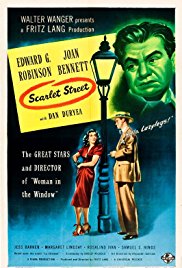 Scarlet Street is easily Fritz Lang’s gloomiest American film. A film with the darkness (both look and subject matter) as his darkest of German films, M. But with that darkness comes some gender politics that are abhorrent and some pity for a character you are not sure deserves it. It’s reminder of why the perspectives we see through in today’s Hollywood are a huge blessing.
Scarlet Street is easily Fritz Lang’s gloomiest American film. A film with the darkness (both look and subject matter) as his darkest of German films, M. But with that darkness comes some gender politics that are abhorrent and some pity for a character you are not sure deserves it. It’s reminder of why the perspectives we see through in today’s Hollywood are a huge blessing.
Lang teamed up with Edward G. Robinson, Joan Bennett and Dan Duryea in 1944 with The Woman in the Window. Since that film was such a success, they all re-teamed for Scarlet Street. Robinson plays Christopher Cross, and lonely and miserable married man who falls for a woman, and possibly a prostitute (Bennett) who is love with her boyfriend, and possibly her pimp (Duryea) and together they steal from pathetic saps. Saps like the aforementioned Cross.
Cross is completely manhandled by life and the film is on his side. His terrifying wife berates him to a comical level. He is an artist with a heart so good that it makes gold look cheap. He is an artist who sees beauty in the world where it doesn’t exist. He can take an ugly flower and make it beautiful with one of his paintings. And he can take an ugly woman like Bennett’s character Kitty and see a beauty that he swears exist, even if the film says otherwise.
Noir filmmaking at its core is about taking average men who are beaten up by life and calls for them to be heroes to a civilization that doesn’t deserve them. The whole genre is an extension of the feelings men had, returning from the war in the 40’s to a society that doesn’t appreciate them. An amount of self-pity and sexism has always been prevalent in the films and it’s important to put in context.
Scarlet Street felt surprisingly sexist not only in the context of other noir films, like Double Indemnity which acknowledged the lead character’s immorality and how he put himself in his situations, as opposed to Cross, who the film says was just an ‘oh shucks’ innocent guy who life just happens too. But also in the context of Lang films himself. Metropolis is easily one of the most progressive films made, for it’s time and altogether, so to see a weirdly regressive take on a genre was disappointing.
That said, Scarlet Street is still a hauntingly beautiful looking film with great performances and fine directing. It would be impossible for the talents of someone like Lang to not come through.
Destiny (Der Müde Tod)
1921, Decla-Bioscop AG, dir. Fritz Lang
by Krystal Lyon
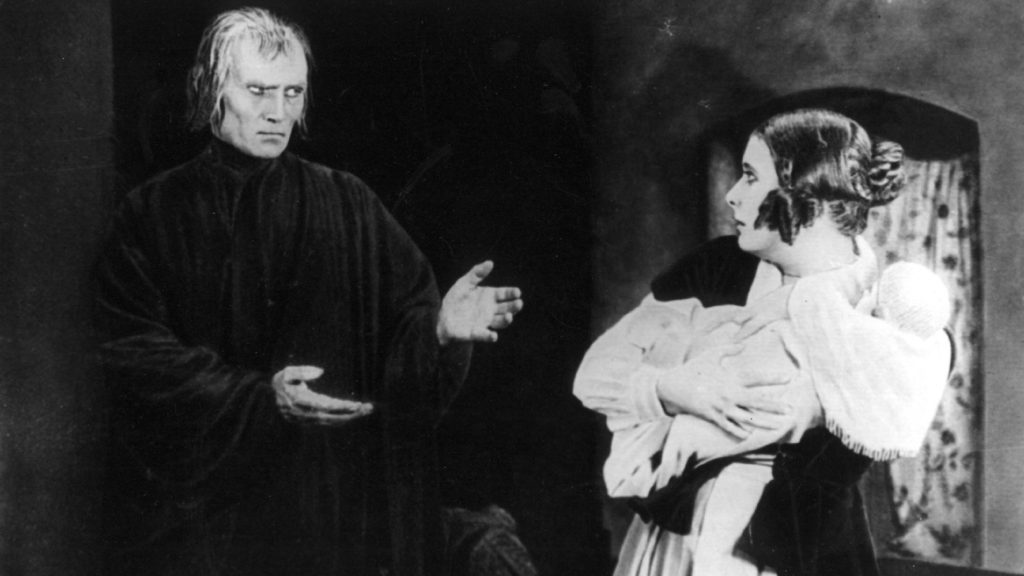
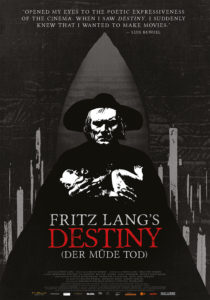 Does Death despise the living or is he merely the servant of the Lord? What would you do to bring someone back from the dead? Longing and fear, love and death, these are the theme’s in Fritz Lang’s beautiful silent parable Destiny (Der Müde Tod). Lang was inspired by the Indian folktale Savitri to make Destiny but the film has heart for personal reasons. Destiny is said to be Lang’s “Most thoughtful and compassionate meditation on mortality” because it comes on the heels of his mother’s death. This is a story that reaches beyond it’s 1921 German Expressionist roots and grips the reality of our own fears in 2018!
Does Death despise the living or is he merely the servant of the Lord? What would you do to bring someone back from the dead? Longing and fear, love and death, these are the theme’s in Fritz Lang’s beautiful silent parable Destiny (Der Müde Tod). Lang was inspired by the Indian folktale Savitri to make Destiny but the film has heart for personal reasons. Destiny is said to be Lang’s “Most thoughtful and compassionate meditation on mortality” because it comes on the heels of his mother’s death. This is a story that reaches beyond it’s 1921 German Expressionist roots and grips the reality of our own fears in 2018!
Let me quickly add that I have very little exposure to silent films. I’ve seen some of the biggies, Metropolis, Nosferatu, The Passion Of Joan Of Arc, Sherlock Jr. and The Kid and they are all favorites. I find that I have to concentrate so much more when I watch a silent film. There’s no room for a cell phone’s tiny screen because your eyes are locked on the big screen! (Or at least they should be.) One cannot serve two screens! I’m also amazed by how much is conveyed with such minimal printed dialogue. Silent films make me want to talk less and observe more. And this concentration and lack of dialogue make the films seem longer than they actually are. I think this is more a statement about my attention span and cell phone usage during films than anything else but that’s what Film Admissions is all about, right?
In Destiny, Lang gives us a look at Death, or Der Müde Tod, Weary Death. Here we have the inspiration for Ingmar Bergman’s Death in The Seventh Seal and every incarnation since in the furrowed brow of Bernhard Goetzke. Tall and lean with dark eyes and hollowed cheeks, Death is weary and burdened by his profession. Cursed for stealing away lives and causing sorrow, Death takes lives at the Lord’s bidding. We are introduced to Death through the young lovers. When the young man (Walter Janssen) dies, his lover (Lil Dagover) drinks poison so she can meet Death and ask for his life back. Death gives her three chances to save his life in alternate worlds, Persia, 15th Century Venice and China. In each she fails because Destiny cannot be altered. Lastly Death offers her one more option, “Bring me the life of another… and I’ll trade you a life for a life.” In the words of Liz Lemon, “That is grim! And I’ve played Monopoly alone!” Do we value our lives and our lover’s lives more than the beggar on the street, more than the sick in the hospital? And that’s all I’m sharing because Destiny is fantastic, beautiful to watch, and it’s surprisingly modern.
All those words and I didn’t get to the AMBITIOUS way it was shot and filmed for 1921, the special effects that are a delight, the exotic staging and cultures that are portrayed and the sheer mass of humanity it must have taken to make Destiny! The stunning 2K-restoration version that Kino Lorber released in 2016 is currently streaming on Netflix. Put down that cell phone and contemplate your own youth and mortality tonight!
The Testament of Dr. Mabuse
1933, Nero-Film AG, dir. Fritz Lang
by David L. Gill

 A genius goes crazy…and begins to write. A therapist seeks what the genius has…but is it to be success? Madness? Both? Neither?
A genius goes crazy…and begins to write. A therapist seeks what the genius has…but is it to be success? Madness? Both? Neither?
Once films began to talk, Lang rose to the occasion. In 1931, M was a masterpiece of editing and sound. The Testament of Dr. Mabuse (1933) would prove to be an excellent third installment of the Mabuse saga.
The film picks up essentially where the previous film left off. Stricken by madness, the man who once functioned as a puppeteer, actor, gambler and active chaotic agent is wasting away in a mental institution. Completely silent for years, he begins to write and does so nearly up until his death. But questions remain: how have the chaotic crimes continued despite his incarceration and illness? Who in their right mind threatens folks with blackmail until they’re on the brink of paying thousands of dollars in hush-money, only to be told, “Nah, don’t worry about it”?
These are questions which characters on both sides of the law are trying to figure out throughout the film. Lang’s direction keeps the audience in suspense. He keeps the material believable, despite having supernatural manifestations. The heroes are smart and use their wits to pin Dr. Mabuse down. But is he really pinned down? What spirit animates these crimes? Was he himself a pawn?
There’s a fascinating sequence in which Dr. Mabuse appears to be either an extra-terrestrial or a demon. I’m inclined toward the second explanation myself, but that doesn’t matter. The therapist seeking to figure out Dr. Mabuse indeed seems to be possessed by this demon/alien as he reads from the texts which Mabuse has written in his otherwise catatonic state. This double-exposure is masterfully done and the acting is superb.
Lang’s character development is subtle, believable, and very much along the lines of an intelligent Bond film. Lang is a pioneer in both spy films and film noir and it is rewarding to see how these folks who are nearly 90 years and half a world away will allow these events to play out. From a thug with a conscience to a doctor with an obsession, the characters are lively and interesting. Karl Meixner’s portrayal of the disgraced agent Hofmeister is really quite brilliant. As he suffers from the trauma of repeated attempts on his life, I felt empathy for him and found his acting to be believable and neither under- nor over-stated. His performance is probably my favorite in the film.
The Criterion Collection is to be praised for their careful presentation of a wonderful restoration of the film. The soundtrack is clear and the image is pristine.
For me, the treat was in watching how Lang chooses to build on the legacy and myth of Mabuse. Not even death, it seems, can stop Mabuse from pulling the strings. Interestingly, Joseph Goebbels, Hitler’s propaganda minister, is reported to have had the film banned because he felt it would cause people to lose faith in their leaders.
But perhaps that is precisely what makes this film feel so modern. In an age of Russian intrigue, conspiracies real and theorized, and competing ideologies, chaos seems to reign. Today’s world seems as if it has Dr. Mabuse’s fingerprints all over it. Even so, perhaps the solution is to be found in re-examining the art—this art—of the past. Who can see themselves in the mirror of history, even a fictional one as Lang has handed us?
And who will be brave enough to learn?

